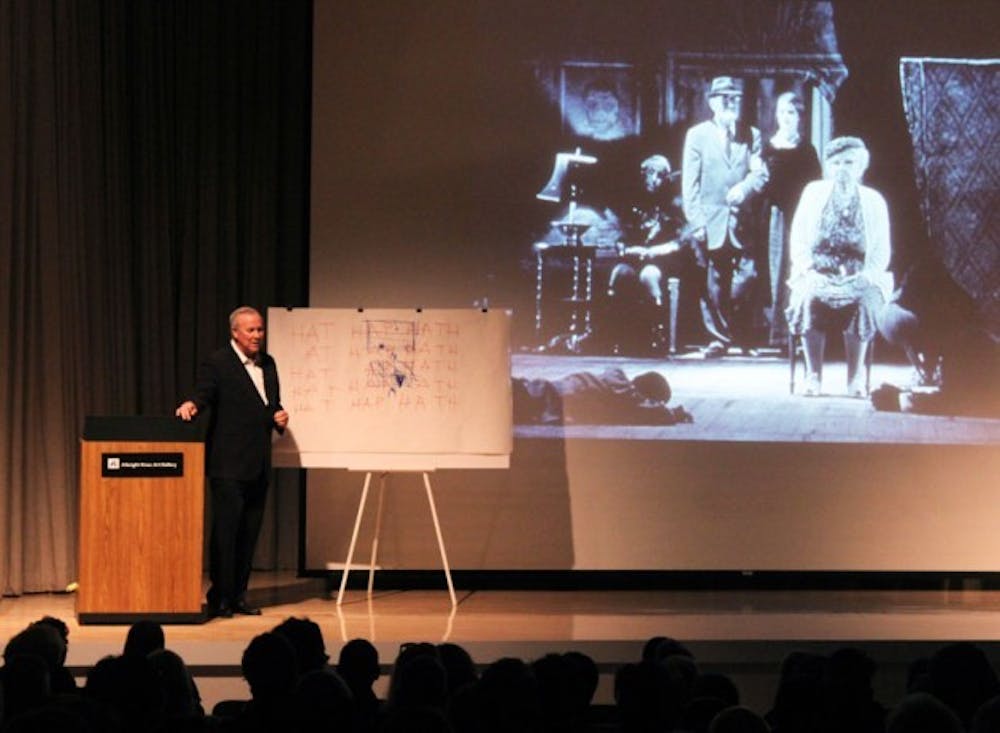His name is Robert Wilson and he once tried to blow up a mountain.
The explosion was meant to be the conclusion to a continuous 168-hour play, staged on seven hills on a mountaintop in Iran with more than 700 participants.
Wilson is known for collaborations with artists and musicians, including Lady Gaga, Tom Waits, Alan Ginsberg and Lou Reed, as well as his own prolific works. He is revered as an important and influential figure throughout the theater world.
He rarely gives public talks, but on Thursday evening he broke his silence with a lecture at the Albright-Knox Art Gallery in downtown Buffalo. The avant-garde theater artist spoke about his 50-year career and his artistic influences.
The lecture was part of the Leslie-Lohman Queer Art Lecture Series, which was organized by Jonathan Katz, the director of the doctoral program in the Department of Visual Studies.
Wilson’s time in Buffalo was accompanied by two screenings of a film he and his production crew shot over the course of his career. It offered an unprecedented look into the iconic artist’s process.
“There may be no more influential theater artist in the last 50 years and there may never be another [as influential as Wilson],” Katz said. “[Wilson has an] openness to learn from other traditions and other cultures [and] a focus on experimentation.”
The multi-talented artist began his lecture by quietly walking to the podium. He stood motionless and silent for two-and-a-half minutes before beginning with a simple “hello.”
Joshua Cruz, a senior media studies major, said he found a connection during the silence because he understood what Wilson was referencing.
“A lot of people looked confused,” Cruz said. “But I knew he was doing 4’33” (an experimental musical piece that is performed in silence) by John Cage … I never lost the connection.”
Wilson’s career in theater began when he stopped a police officer in New York City from beating a 13-year-old deaf African-American child named Raymond. After a long legal process, the artist adopted the child.
Raymond was never given a formal education or taught how to speak, so he expresses himself through visuals; the perspective that first inspired Wilson to think differently about theater.
After observing Raymond’s drawings, Wilson wrote Deafman Glance, a seven-hour silent film. The film was a huge success in a Parisian theater, selling out to a crowd of 2,200 each night for nearly six months. This film established Wilson’s reputation at the forefront of avant-garde theater.
Wilson continued searching for new ways to look at theater throughout his 50-year career. He never strayed from experimentation.
“If we know what it is we are doing, there’s no reason to do it,” Wilson explained during the lecture.
The best example of this experimentation was his play performed in 1972 over the course of 168 continuous hours. The play, inspired by Raymond’s drawings, was performed on seven different hills on a mountain in Iran that incorporated more than 700 participants throughout the seven-day period, according to the artist’s website.
The first day of the play took place on the first hill and the second day took place on the first and second hill and so on. By the end of the seventh day, there was activity on all seven hills.
“I could not possibly write and direct a play that was seven days long so I created a big mega-structure that I divided into hours with 24 segments a day,” Wilson said in a text for the catalogue accompanying the exhibition “Iran Modern” at the Asia Society Museum in New York City.
Wilson originally wanted to blow up the mountain at the conclusion of the 168-hour play, but he wasn’t allowed to do so.
The eccentric visionary also spoke of Christopher Knowles, another young boy who helped inspire his vision. The artist received a tape of Knowles making sounds and speaking seemingly random words. When Wilson met with Knowles, he realized the young boy organized his thoughts geometrically – when they were written down, the words and sounds Knowles spoke formed shapes and designs.
Wilson’s play Letters from Queen Victoria was based off of Knowles’ curious method of organizing his thoughts. The experimental play, successful in Europe, failed in New York, due to its lack of traditional structure. The opera had no continuous stream of consciousness.
Many critics felt Wilson was taking advantage of a brain-damaged child, which Knowles and Wilson claimed was not the case.
Wilson felt he was giving the child a chance to express himself.
It was cases like these that moved Katz to say he feels Wilson is one of the very few artists that deserves to be called great.
“I found what he said very inspirational,” Cruz said. “He described himself as a person who helped people who [other people] thought had no hope. As humans, we’re quick to judge and give up on people we barely know – sometimes in our family or in our [selves].”
As someone revered by the media as a forefront avant-garde theater artist, Wilson’s lecture and film screenings gave those in attendance an insight into the life, and mind, of an artistic icon.
Jordan Oscar contributed reporting to this story.
email: arts@ubspectrum.com
A previous version of this article incorrectly stated Christopher Knowles was institunalized.





